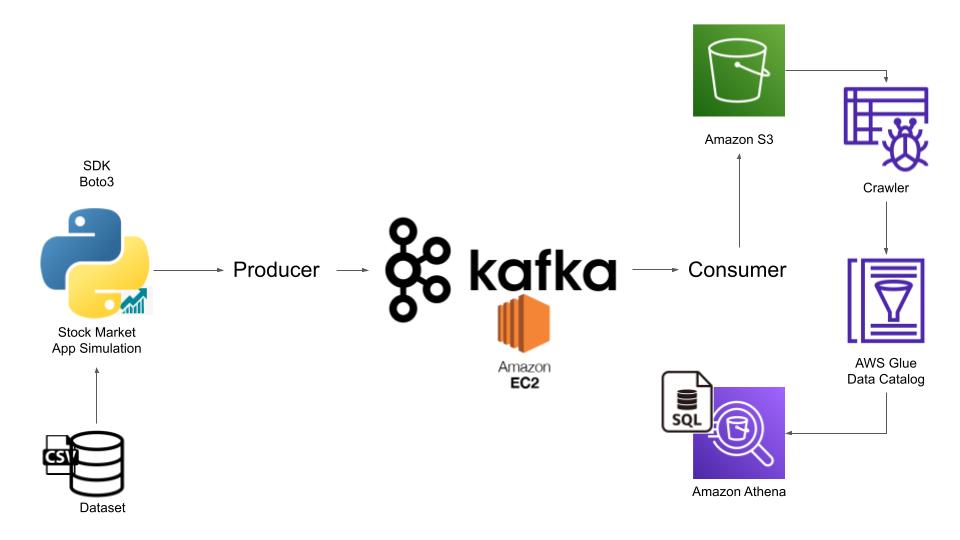This project simulates stock market data streaming, processes the data in real-time using Kafka, and analyzes it with AWS Glue and Athena. Below, you'll find an overview of the architecture, setup instructions, and usage details.
- System Architecture
- Deployment Steps
- Implementation Steps
- Technology Stack
- Best Practices and Tips
- Resources
-
Launch EC2 Instance:
- Select an Amazon Linux 2023 AMI.
- Configure instance details (e.g., security group with port 9092 open).
-
Install Java Runtime:
sudo yum update -y sudo amazon-linux-extras enable java-openjdk11 sudo yum install java-11-openjdk -y -
Install and Configure Kafka:
- Download Kafka:
wget https://downloads.apache.org/kafka/3.5.1/kafka_2.12-3.5.1.tgz
- Extract and set up:
tar -xvf kafka_2.12-3.5.1.tgz cd kafka_2.12-3.5.1
- Download Kafka:
-
Start Kafka Services:
- Start Zookeeper:
bin/zookeeper-server-start.sh config/zookeeper.properties
- Start Kafka Broker:
bin/kafka-server-start.sh config/server.properties
- Start Zookeeper:
-
Create a Kafka Topic:
bin/kafka-topics.sh --create --topic stock-market-data --bootstrap-server localhost:9092 --partitions 1 --replication-factor 1
- The producer script streams simulated stock market data to Kafka.
- The consumer script processes the data in real time and stores it in an S3 bucket.
- Use the producer Python script to read from a sample CSV dataset containing stock prices and trades.
- Configure the producer to publish records to the Kafka topic
stock-market-datain real-time.
- Set up an EC2 instance and install Kafka.
- Configure the
server.propertiesfile to set up the Kafka broker. - Create and verify the Kafka topic
stock-market-data.
- Deploy the consumer Python script to read messages from the Kafka topic.
- Store the consumed data in an Amazon S3 bucket, organized into partitions (e.g.,
/year/month/day/). - Use separate folders for
raw-data/andprocessed-data/.
- Create an AWS Glue crawler to scan the S3 bucket.
- Generate a schema and populate the AWS Glue Data Catalog.
- Schedule periodic crawls to keep the schema updated.
- Connect Amazon Athena to the AWS Glue Data Catalog.
- Write SQL queries to analyze the data
- Kafka: Data streaming.
- Python: Producer and consumer implementation.
- AWS EC2: Kafka hosting.
- AWS S3: Data storage.
- AWS Glue: Data catalog creation.
- Amazon Athena: Real-time querying.
- Kafka Configuration: Use appropriate partitioning and replication strategies for scalability.
- AWS Glue: Schedule crawlers for periodic updates.
- S3 Organization: Use a structured folder hierarchy for easier data management.
- Monitoring: Set up monitoring tools for Kafka and AWS resources to track performance and troubleshoot issues.
- Architecture Diagram: Included in this repository.
- Dataset: Simulated stock market data in CSV format.
- Python Notebooks:
- Producer notebook for data simulation.
- Consumer notebook for data processing.
- Kafka Configuration:
- Step-by-step instructions for setting up Kafka.
Feel free to fork this repository and contribute! 😊
